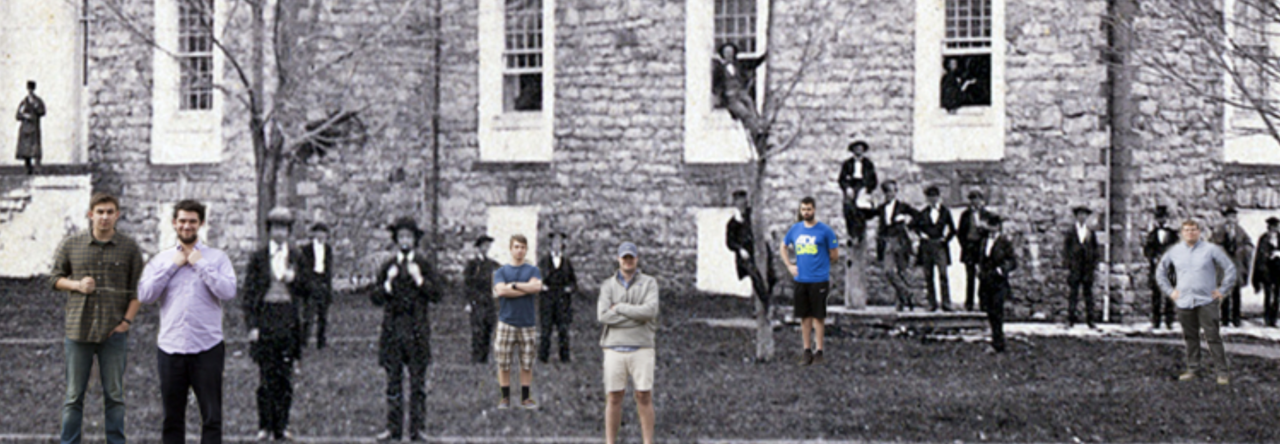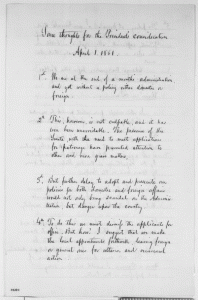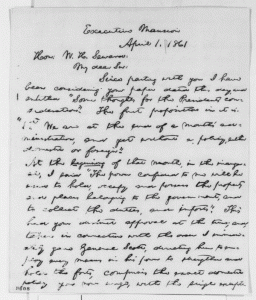By Moyra Schauffler
No Secretary of State, or cabinet member, had ever or has ever submitted a document quite like William Henry Seward’s April Fool’s Day Memorandum entitled “Some thoughts for the President’s consideration”. [1] The document was both critical and presumptuous with its assessment of Abraham Lincoln’s first month in office and its list of recommendations that Seward believed would better serve the country in the midst of the secession crisis. However, the seemingly void-of-potential President, successfully shut down Seward’s propositions on the same day he received the letter, with an eloquent but firm response that provides a snapshot of Lincoln’s firm grasp of his role as president. Although Lincoln wrote his response to Seward, he in fact read it aloud, which surely gave clear emphasis on Lincoln’s assertion that he alone made the policy of the United States and that if he felt the need to do so, could seek the advice of the cabinet, but that the cabinet could not do this job for him. [2]
At this point in the build-up to the Civil War, Seward was dissatisfied by the trajectory – or lack thereof – of the President’s domestic and foreign policies. Seward’s frustration primarily lay in the fact that he maintained a deep belief that he would have been a better president than Lincoln. [3] However, he also had “dominated the Republicans’ response to the [secession] crisis…” and now, “suddenly found himself left in the…impossible position of advocating…a minority view [within the cabinet].” [4] Seward’s recommendations throughout the memo provide insight on his personal opinion and frustration with the President’s first month in office. He concluded the memo by stating the importance of asserting these policies, and that the President should either pursue these changes on his own, or bestow the responsibility to one of his cabinet members. [5]
Throughout his response, Lincoln methodically picked apart each of Seward’s complaints and recommendations. He did this by quoting Seward’s original letter and then offering a rebuttal to the Secretary of State’s proposition. For example, Lincoln wrote:
The first proposition in [your memorandum] is, “1st. We are at the end of a month’s administration, and yet without policy, either domestic or foreign.” [6]
He then asserted that throughout the first month of the administration, that he created policies, which he believed Seward approved. In this section the domestic policy described by Lincoln and Seward is the controversial issue of Federal forts in Southern territory. Leading up to April 1861, both Fort Sumter in Charleston Harbor, South Carolina and Fort Pickens on Santa Rosa Island, Florida occupied the leaders’ attention. Although Seward and Lincoln agreed that a civil war should be avoided, the two did not agree on the course of action regarding Federal control of the forts. In his memo, Seward stated that he wanted to transfer control of Sumter to South Carolina in order to appease the Carolinians and change the focus of the rapidly approaching war from a question of slavery and party politics to a question of “Union or Disunion”. Seward then wrote:
For the rest, I would simultaneously defend and reinforce all Forts in the Gulf, and have the Navy recalled from foreign stations to be prepared for a blockade…I would maintain every fort and possession in the South.”
Lincoln did not agree with Seward’s hypocritical policy of giving up one fort but keeping control of the rest. Lincoln believed that refusing to give all Federal forts in Southern territory to the belligerents and then reinforcing them with adequate supplies was the best course of action. In his letter to Seward, Lincoln recalled his inaugural speech on March 4th, in which he stated he would, “…hold, occupy, and possess the property and places belonging to the government…” He then wrote:
…I do not perceive how the re-inforcement of Fort Sumpter would be done on a slavery, or party issue, while that of Fort Pickens would be on a more national, and patriotic one.
In the end, Lincoln employed both secret and public efforts to re-supply Fort Sumter and Fort Pickens in order to maintain Federal control and keep the Confederates at bay. According to James McPherson, Seward’s efforts prior to his April 1st letter, such as diverting, “the strongest available warship from the Sumter expedition” were unsuccessful in fulfilling his desire to prevent war by appeasing the belligerents. [7] Ultimately the North was unable to hold Fort Sumter and Major General Robert Anderson surrendered the fort on April 14th, 1861 after thirty-three hours of Confederate shelling. [8] The second section of the memo complemented Seward’s goals to prevent civil war through appeasement by starting war with Europe as a way to unite the country under one flag.
Seward’s original letter to Lincoln begins the section regarding foreign policy with the title “For Foreign Nations”. Throughout this portion, Seward named several different ways he wished to prevent a war between the states and instead, start a war with the major European powers. Seward wrote:
I would demand explanations from Spain and France…I would seek explanations from Great Britain and Russia, and send agents into Canada, Mexico and Central America, to rouse vigorous continental spirit of independence on this continent against European intervention. And if satisfactory explanations are not received from Spain and France, Would convene Congress and declare war against them.
This list of Seward’s policy recommendations surrounds the Spanish annexation of Santo Domingo – modern day Dominican Republic – that occurred on March 18, 1861. Walter Stahr offers helpful explanations for why Seward named the European powers he did, and why they might have been a target for a war with the United States. According to Stahr, Seward was apprehensive of the annexation because Spain directly violated the 1823 Monroe Doctrine, and the United States needed to respond accordingly in order to protect hemispheric security. In the case of France, Seward likely referred to French interest in Mexico or a plan to annex Haiti, which would have been another violation of the Monroe Doctrine. [9] Stahr speculates that the animosity towards Britain may be connected to the “possibility” that the country would admit the sovereignty of the Confederacy to ensure continued cotton imports. [10] Finally, Stahr explains that the reason behind Seward’s call to “seek explanations” from Russia is largely unknown. One story is that, according to his son, Frederick Seward, his father referred to the possibility of Russia recognizing the Confederacy, but there are no primary source documents that attest to this theory. [11]
Lincoln’s response to Seward’s demands to start war with Europe in order to unite the country speaks for itself. The president completely ignored the suggestions to “seek explanations” from Spain, France, Britain, and Russia, and did not authorize agents to go to Canada, Mexico, and Central America for the purpose of rousing “vigorous continental spirit”. Instead, all Lincoln wrote in his response was:
The news received yesterday in regard to St. Domingo, certainly brings a new item within the range of our foreign policy; but up to this point we have been preparing circulars, and instructions to ministers, and the like, all in perfect harmony, without even a suggestion that we had no foreign policy.
In this section, Lincoln explained to Seward that he had not had the time to come up with a specific foreign policy for the ongoing crisis in Santo Domingo. He also emphasized that throughout the month when he and the Secretary of State discussed similar policy matters and “gave instructions to ministers”, there was no sign that Seward believed the administration “had no foreign policy”.
The most significant aspect of Abraham Lincoln’s response to William Seward’s memo lies at the end of the document when Lincoln affirms his role as Commander and Chief. Following the rebuttal to the accusation that the administration lacked a coherent foreign policy, the President quoted the last portion of Seward’s memo:
Whatever foreign policy we adopt there must be energetic prosecution of it. For this purpose it must be somebody’s business to pursue and direct it incessantly. Either the President must do it himself…or Devolve it on some member of his cabinet.
Lincoln’s negative response to the suggestion of a cabinet member taking control of creating American domestic and foreign policy showed the President’s opinion of his role and the role of his cabinet. He wrote:
I remark that if this must be done, I must do it. When a general line of policy is adopted, I apprehend there is no danger of its being changed without good reason, or continuing to be a subject of unnecessary debate; still, upon points arising in its progress, I wish, and supposed I am entitled to have the advice of all the cabinet.
The emphasis on Lincoln’s responsibility to authorize the domestic and foreign policy of the United States is the most important part of his response. After a hectic few weeks in office during which the President exhibited a certain lack of “executive abilities”, Lincoln successfully asserted himself within his own administration and set the tone for the remainder of his time in office. [12]
Scholars ultimately disagree over the importance of Lincoln’s response to Seward’s, “Some thoughts for the President’s consideration”. According to Adam Goodheart, the letter to Seward on April 1st constituted a significant turning point in the beginning of Lincoln’s time in office. Goodheart writes that although Seward’s memo was “insulting”, it lifted the President out of the “funk” he was trapped in during the days prior to April 1st. The author goes on to emphasize how important that, “the upstart lawyer from Illinois, had now bid defiance to…the nation’s most powerful…politician” was. [13] Finally, Goodheart argues that the response was a turning point because Lincoln realized that his cabinet was unable to provide the right answers to the biggest questions that faced his administration, and that although they were available to help, “The path ahead would be his alone.” [14]
In contrast, Michael Burlingame describes the exchange in his work Abraham Lincoln: A Life as just one of many examples of Seward’s attempts to strong-arm the President. Burlingame cites actions by Seward after his conversation on April 1st that demonstrate how Lincoln’s words failed to change the Secretary of State’s ambitions. [15] For example, Burlingame explains that two days after Lincoln refused to accept his policy recommendations, Seward – clearly peeved that the administration had not changed its domestic and foreign policies – informed The New York Times about his recommendations, and the newspaper ran an editorial entitled “Wanted – A Policy”. [16] The editorial reinforces Seward’s criticisms of Lincoln’s approach to policy making and demonstrates the Secretary of State’s opinions remained unchanged after the April 1st meeting. Ultimately, by continuing to try to undermine the President through public printing of policy recommendations and accusations, Seward demonstrated he had learned little from Lincoln’s firm response to the April 1st memorandum. This viewpoint on the importance of the exchange between Seward and Lincoln outlines the complexity of the relationship between the two, but also bolsters the importance of both documents as a snapshot of the mechanics of the Lincoln administration’s first month in office.
There is no documentation that describes Seward’s reaction to Lincoln’s oral response to the memorandum. [17] Seward was likely shocked because he had been so sure of the Lincoln’s approval of his suggestions that he called The New York Times‘ editor-in-chief, Henry Jarvis Raymond, to Washington to be able to immediately telegraph the news of Lincoln’s approval of Seward’s policies. [18] Unfortunately for Seward – and Raymond, who had no big story to report – the President refused his policy recommendations and assured the Secretary of State that he could handle the policy-making. On April 1, 1861, Lincoln clearly made his point because Seward eventually backed down. Although the President and the Secretary of State maintained their own strong opinions, throughout their time in office, they were able to work closely together and had a strong trust in one another that allowed them to successfully maneuver the country through the Civil War.
Works Cited
[1] Lawrence M. Denton, William Henry Seward and the Secession Crisis, North Carolina: McFarland and Company (2009), 140.
[2] Geoffrey Perret, Lincoln’s War, New York: Random House (2004), 23-24.
[3] Perret, Lincoln’s War, 13.
[4] Adam Goodheart, 1861, New York: Alfred A. Knope (2011), 158.
[5] William Henry Seward, “Some thoughts for the President’s consideration,” The Abraham Lincoln Papers, Library of Congress, April 1, 1861, http://memory.loc.gov/cgi-bin/query/r?ammem/mal:@field(DOCID+@lit(d0866000)).
[6] Abraham Lincoln to William Seward, The Abraham Lincoln Papers, Library of Congress, April 1, 1861, http://memory.loc.gov/cgi-bin/query/r?ammem/mal:@field(DOCID+@lit(d0860800)).
[7] James McPherson, Battle Cry of Freedom, New York: Oxford (1998), 270.
[8] McPherson, Battle Cry of Freedom, 270.
[9] Walter Stahr, Seward, New York: Simon & Schuster (2012), 271.
[10] Stahr, Seward, 271.
[11] Stahr, Seward, 272.
[12] Stahr, Seward, 272.
[13] Goodheart, 1861, 159.
[14] Goodheart, 1861, 159.
[15] Burlingame, Michael, Abraham Lincoln: A Life, Johns Hopkins University Press (2008), http://www.knox.edu/about-knox/lincoln-studies-center/burlingame-abraham-lincoln-a-life, 2376.
[16] Burlingame, Abraham Lincoln: A Life, 2380-2381.
[17] Stahr, Seward, 273.
[18] Goodheart, 1861, 158.








Leave a Reply